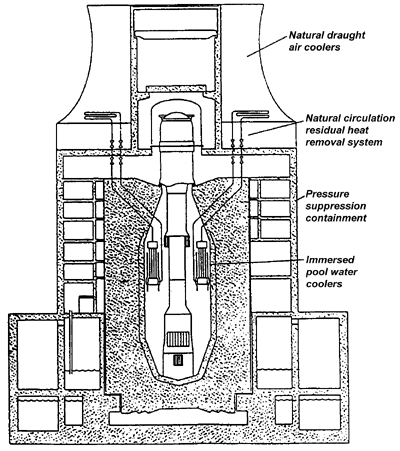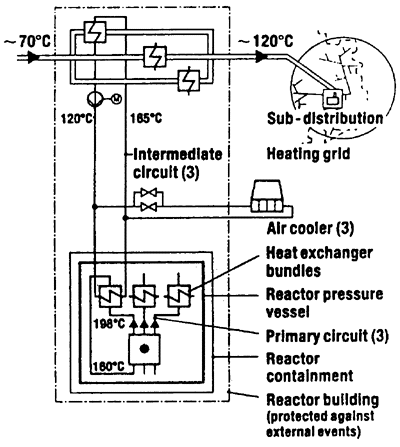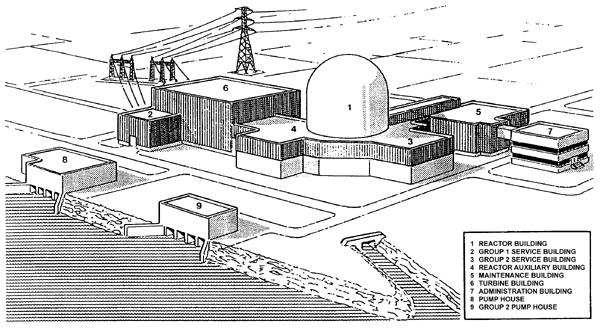I. What are SMRs?
SMRs are small and medium-sized reactors. They are generally defined as reactors having about or less than 600 megawatts (MW) of power output, and that are used either for electricity production, for heating, or in a co- generation mode for producing both electricity and heat.
II. Evolution of SMRs
All the present types of large reactors are represented in the SMR lines, although the latter make use of certain technological features that are not easily applicable to larger reactors. As an example, most SMR models include passive safety systems, which are easier to install in plants smaller than the standard 1000-1300 MW size. In all cases, there is emphasis on simplification and its expected benefits, in order to make them competitive with alternate types of electricity or heat generation plants. For instance, they are designed to be built in the factory and assembled quickly on site, in much less time than has been the case for large reactors.
While the SMRs dedicated to electricity production generally tend to be an evolution of the larger reactors, the heating reactors show a much greater departure from their large cousins. Many different heating reactor concepts are available. Although designed to meet different criteria, they share certain characteristics: low power ranges, supply temperatures less than 130 degree C, and lower power density than large reactors (less energy produced in a given volume).
III. Why SMRs are being developed
The incentive for the development of SMRs comes from different sources. In some countries, the R&D efforts have been the result of economic and environmental considerations:
In other cases, SMRs are being developed in answer to specific user requirements, mostly in relation to safety and public acceptance issues. The requirements issued in different countries have a number of common points:
SMRs seem to respond well to these requirements, because they allow for design simplification and for introduction of new features, such as passive components and processes that avoid the need for early action by the operator in an abnormal situation. The design of some SMRs also makes it possible to set clearer and more precise safety criteria that may be easier for the public to understand, for example the exclusion of any possibility of a radioactive release to the environment. Some experts contend that the engineering principles are more readily explainable to the non-specialist, which should improve public acceptance.
Figure 1. Safety structures (PIUS-600 ABB)

IV. What is the potential for SMRs
There is potential for penetration of SMRs in two sectors of the world's energy markets.
In the electricity sector, the scope for penetration may be constrained by the need to be cost-competitive with the well-established large reactor systems. However, the nuclear industry is not unanimous in accepting the "economies of scale" argument that seems to favour large plants, and some SMR designs show prospects of competing with larger designs. In fact, the SMRs of about 600 MW are expected to have a cost per MW in approximately the same range as a large reactor.
Factors that could favour a reasonably competitive SMR in electricity markets include a lower initial capital investment and correspondingly reduced investment risk, and the ability to meet demands not readily open to large reactors. For example, in regions with a slow increase in electricity demand or for utilities with small distribution networks, SMRs may represent an interesting alternative. This aspect is particularly important for developing countries.
There is extensive scope for applications in the heating sector, where there has been little penetration of nuclear power up until now. The market in this area can be divided in two: process heat for industrial applications, and district heating. The latter is theoretically the largest market, with a requirement for low-temperature heat. However it requires a type of heat distribution network that is not widespread. Process heat, on the other hand, is used by industry, and usually demands much higher temperatures. This is a localised demand that does not require an extensive heat distribution network.
Current environmental issues could lend support to arguments for SMR expansion into the heating sector that is not, in general, open to large reactors. However, district heating markets are currently restricted to specific countries, which are generally in the northern climates and where heat distribution networks already exist. The obvious immediate market for SMRs is the replacement of existing fossil-fuelled heating systems. Further use of SMRs for district heating would require a concerted effort to install new distribution networks.
Industrial (or process) heat markets lie mainly with large industrial complexes, where economics could also favour a co-generation system rather than a dedicated plant. Small reactors have a definite advantage over large ones in this sector, as the need for guaranteed heat in order to keep industrial processes operating requires multiple units. The main competitors for SMRs use fossil fuels; at low prices prevailing until mid-1990, it was questionable if SMRs could compete. However, the prices increased suddenly in late 1990, and while they may decrease in the short term, they can be expected to rise again as demand grows. Meanwhile, continuing development should bring a reduction in the cost of SMRs. Increasing uncertainty regarding the supply of fossil fuels may also become a factor supporting the penetration of SMRs into these markets.
Figure 2. Simplified overall system of
a nuclear heating reactor

V. What are the impediments to deployment
of SMRs?
There are various factors working against the introduction of SMRs, but many of these impediments affect any new technological product: specific needs must be identified, markets must be developed, and the product has to prove itself.
Factors impeding the deployment of SMRs can be divided into technological and economic categories.
Technological factors
A potential solution could be to aim as soon as possible for a demonstration of the advantages of SMRs. This could be most effective in the framework of an international joint venture. In any case, an important goal would be to reduce the number of designs.
Economic factors
Possible solutions to these problems could be to consider SMRs as complementary to -- rather than as competitors of -- large reactors in the energy market, to consider parks of several small units on the same site, to aim at a standardization of plant construction and type licensing, and to share financial risks through international co- operation. One should also compare alternate forms of energies based on all relevant aspects, including costs not borne by the producers, such as pollution or health effects.
There are other factors that may affect the deployment of SMRs. Part of the population is generally opposed to any form of nuclear energy, although, as mentioned earlier, the opposition may be less in the case of smaller reactors. There is also general uneasiness with regard to advanced technology, as well as fear of radiation. Opposition to SMRs in particular could also come from the concern that, because of their smaller size, there could be more of them on more sites, and that these sites could be closer to home.
Potential remedies to this situation could be to establish clearer and more definite safety criteria, in addition to the usual ones that are based on assessment of probabilities and which are more difficult for the public to understand, to co-ordinate safety approaches among countries, to intensify information of the population, and to provide politicians with the necessary arguments for their dialogue with the public.
Figure 3. Station layout of CANDU 3 (AECL-Canada)

VI. What could be done at the international
level?
There are four areas that could be addressed by the international community: rationalisation of reactor types, public perception, licensing, and the construction of the first prototypes.
The nuclear industry has produced many concepts and types of reactors. As the industry rationalises its structures through mergers and acquisitions to reduce duplication of efforts, the number of types of reactors is being reduced. Only the most commercially viable ones are being retained, and hopefully the best technical ideas will merge into a smaller series of products. This rationalisation is being done by the industry itself for financial reasons.
At the same time, national organisations have established bilateral information exchange agreements. The combined efforts of these organisations and companies, though not necessarily co-ordinated, permit significant reduction of duplication of effort.
The problem of public perception has already been touched upon. There is a need for various national and international agencies to provide timely and credible information to the public on SMRs, for example on their safety and economic characteristics, so that informed judgements can be made on these reactors.
It would also be useful to achieve some form of standardization of regulations, where, for example, an internationally approved, uniform set of licensing requirements for SMRs could be developed through effective co-operation between the appropriate parties. One possible benefit of standardizing the requirements could be a significant reduction in the cost of construction. One of the potential advantages of SMRs is that much of the fabrication can be done in a factory environment. Given a sufficient level of standardization of the product, a relatively larger number of units could be produced in a given time span, thereby reducing the unit cost.
Finally, the question of development of the first prototype must be tackled. To be attractive to potential users and to attract the necessary funds, the benefits of these reactors must be demonstrated. As the reactors become more standardized and can be built by -- and in -- different countries, an international approach may be called for, where technical and financial resources can be pooled.
REFERENCE
Home - About NEA - Work Areas - Data Bank - Publications - Press Room - Search
� 2008 Organisation for Economic Co-operation and Development
Home - About NEA - Work Areas - Data Bank - Publications - Press Room - Search
� 2008 Organisation for Economic Co-operation and Development